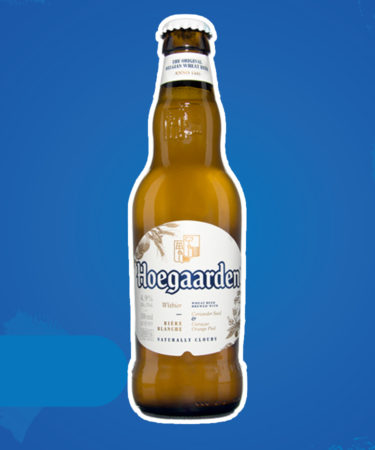Enjoyed in 70 countries. Misunderstood in ours. Crafty before craft was such a big deal. Started by a milkman and now owned by the biggest brewing company in the world.
Hoegaarden doesn’t necessarily rank among the sexiest beer to bring to a party. If anything, it occupies squarely awkward territory in the beer world: There’s too much of it to be craft, yet it’s too multidimensional to be chugged like a macro lager.
All this would bother us more if it weren’t just easier to drink the stuff and let categorization be damned. Here are nine things to know about Hoegaarden.
Hoegaarden kind of ‘pre-crafted’ craft beer.
If we’re to believe most million-dollar beer advertisements, brews should be consumed in frosty mugs, ideally in proximity to mountains and/or bikini-clad women. Hoegaarden doesn’t pander to that stereotype. Years before craft beer had us all nervously rethinking beer-serving temperature and glassware, Hoegaarden was asking the Budweiser faithful to take a chance on an unfiltered, citrusy-spiced European recipe with ancient religious roots and little to no apparent sex appeal. And it worked.
Hoegaarden is both 6 centuries and 50 years old.
Monks tend to give us good things: quiet contemplation, statement haircuts, an “every day is casual Friday” work wardrobe, and beer. As early as the mid-15th century, Belgian monks were getting laymen soused with a witbier-style prototype, thanks in large part to globetrotting Dutch traders who ferried ingredients like Curacao orange and coriander to places on the map with no climatological right to them. Witbier basked in popularity for centuries, then trickled into near-obscurity only to be born again — though just barely — in the 1960s.
A milkman saved Hoegaarden.
Scotch was born in Scotland. Hoegaarden was born in Hoegaarden. At press time we have no idea where Nesquik comes from.
In its heyday, the relatively small Belgian village of Hoegaarden was bursting with breweries — 38 in 1758, or one brewery for every 58 of its 2,000 villagers (and, presumably, several cops to subdue each drunken villager). As fermentation styles and tastes changed over the centuries, Hoegaarden’s breweries suffered, losing ground to bottom-fermented lagers and pilsners. By 1957, the last brewery closed its doors. Enter local dairyman Pierre Celis, who singlehandedly revived the style. As legend has it, he did so with just one cowshed, 21 barrels, and a dream.
Then Hoegaarden kicked out the milkman.
The brewery Pierre Celis founded essentially ousted him. When it entered the international market in the 1970s and ’80s, Hoegaarden had to compete against wildly popular, insanely drinkable lagers. Complex, hazy ales like witbier had to either compromise or reconsider going to grad school. Celis wasn’t having any of it — his witbier was authentic, the kind of brew a 15th-century monk would chug and then high-five you for. So he exited the company in 1989. Hoegaarden is now owned by none other than brewing megalith AB InBev.
It’s a witbier, which doesn’t mean ‘wheat beer.’
Once you realize you truly love beer (welcome, friend), you take certain reasonable pains to become acquainted with certain terminology. (More smart beer words mean more beer for mouth.) You’ve probably heard the term weissbier and maybe even heard witbier. They sound similar, but weissbier means “wheat beer” while witbier means “white beer.” Say that three times fast. Witbiers like Hoegaarden are in fact made with 50-percent-minimum unmalted wheat, which adds light grainy flavors to the mix, but they’re referred to as “witbier” because they’re unfiltered and hazy or milky.
It’s been ‘bottle conditioned.’
Hoegaarden gets its taste from three key factors. Firstly, it’s unfiltered — hence the milky or hazy appearance and thicker texture. The recipe is lower in hops, subbing in aforementioned orange and coriander. Finally, it’s “bottle-conditioned.” Don’t let the term freak you out: Bottle-conditioned simply means the already fermented beer has a second round of yeast added to the bottle this time in order to create carbonation. The finished product ends up being a bit of a trickster: It looks like it’ll go down creamy, but zingy carbonation and spicy citrus kick make for a dry, almost quenching finish.
An orphan is the mascot.
Vineyards have dogs and breweries have cats (seriously, tons of breweries have cats). But Hoegaarden has an extra special, if unofficial, mascot: an orphan brewmaster. Two words that might never have been joined come together in Hoegaarden lore, which tells of an abandoned orphan raised by monks and schooled in the art of brewing. According to the book “Beernomics,” the orphan — nicknamed Klaas, for cloister — would grow up to be an expert brewmaster, so enamored of a life lived in beer he even chose to die by it, “buried in a beer barrel at the age of 100.”
It’s related to gruit.
Gruit was an early proto-beer that used herbs and spices as a preserving and bittering agent, back when hops weren’t as widely cultivated or fetishized as they are now. There’s been a mild resurgence in gruits lately, but you can consider witbiers their mild-mannered great-grandchildren, continuing the tradition of de-emphasizing hops in favor of other flavors.
There’s a special hexagonal glass because…?
Like Champagne and bachelorette parties, Hoegaarden has its own glassware, a sturdy, flat-bottomed hexagonal glass that looks like it would be as comfortable brimming with Sunny D as Belgian witbier. As with most beer glassware, there’s logic to the shape: The hexagon opens up to cultivate a sturdy foam, with a wider mouth that lets the citrus and spice and bready aromatics catapult themselves into your nasal passages as you sip.
